Forex liquidity providers are a key part of the Forex market, allowing customers to trade currencies easily at a mutually agreed-upon price for a specific quantity. Without such technology, brokers wouldn’t be unable to offer their clients their services. This article will show the importance of Forex LPs and how they contribute to stabilizing the market.
What are Forex liquidity providers, and what is their mission?
In simple terms, Forex liquidity providers are financial organizations specializing in providing the currency which facilitates transactions in the Forex market. Such providers play an important role in fostering trades, supplying the funds and liquidity brokers to offer their services. Also, it should be emphasized that by providing the necessary funds for trading, LPs often act as market makers and dealers, enabling them to help set prices and ensure smooth operations in the Forex market.
Liquidity providers are affected by several factors, such as regulatory changing market conditions, requirements, and client demand. It follows that they must continuously evolve and adapt to keep up with changing market conditions and meet the needs of our customers.
Why are Forex liquidity providers important for brokers?
As stated above, FX liquidity providers are vital in simplifying trades and guaranteeing brokers can seamlessly offer their services to customers. These providers make the broker’s work much easier to help them obtain the currency needed. Additionally, LPs frequently tend to act as dealers and market makers. Consequently, they are an integral part of the ecosystem where brokers can provide services and earn profits.
The relationship between brokers and LPs is symbiotic, allowing both parties to thrive in this dynamic and fast-paced market environment. To ensure expeditious trading operations and maximize profitability, brokers cooperate with LPs to get their services and expertise. By closely collaborating with LPs, brokers can stay up to date on changing market conditions, access a wide range of resources and trading tools, providing high-quality services that meet the expectations of their clients.
How do different types of LPs compare in terms of costs, speed, and reliability?
Different LPs offer distinct advantages concerning cost, speed, and reliability. Banks are considered the most stable, reliable, and secure liquidity sources, but, on the other hand, they also may be the most expensive. For instance, NBFIs or Non-bank financial institutions usually offer a more competitive pricing model, but they are not meant to be as reliable and established as banks. Electronic Communication Networks (ECNs), arranging high execution speeds and low costs, do not always provide the same liquidity level as other providers. So, it’s recommended that the brokers carefully compare different LPs’ offerings to find the best fit for their needs.
-
Cost
Banks are supposed to frequently be one of the most expensive providers of liquidity due to their high overhead costs and other expenses. NBFIs usually offer more competitive pricing models, although this depends on factors such as the provider’s size and the market’s level of competition.
-
Speed
So the argument goes, the fastest type of LP is ECNs, which utilize complex trading technologies to provide high-speed transactions. Although several banks and NBFIs may also provide comparatively quick execution time depending on market conditions.
-
Reliability
As banks have a strong reputation for security and stability alongside a long history in the financial industry, they are generally considered one of the most reliable sources of liquidity. At the same time, newer or smaller LPs tend to be less reliable considering issues such as insufficient capital, lack of experience, or limited resources. Generally, it is crucial for brokers to carefully assess the reliability, stability, and security of any potential LP before making a business.
What aspects should brokers consider when choosing LPs for their trading activities?
Regarding trading activities, brokers should consider a set of key points when choosing an LP to work with. It consists of market penetration, technological infrastructure, and, as stated previously, cost, speed, and reliability. Other equally essential criteria may include the provider’s size, its regulatory status, and reputation in the industry. Lastly, before selecting an LP that complies with their specific demand, it wouldn’t be amiss for brokers to do their own research and weigh all available options.
What are some of the challenges faced by Forex LPs?
LPs commonly face one difficulty: constantly evolving and adapting to keep pace with changing market conditions, not to mention that these providers must also follow the regulators’ requirements and other parties staking in the FX market. Consequently, many competitive pressures and factors can impact the operations of these providers.
On the other hand, heightened regulatory requirements, rapidly changing technology trends, and increasing client demand for high-quality services challenge LPs, so they must also manage their risk exposure efficiently while maintaining low operational costs. Overall, how these providers will overcome these challenges will determine their ability to succeed and continue growth.
How are Forex LPs likely to evolve in the future, and what impact will this have on brokers?
As the market and technology change, liquidity providers in Forex are likely to continue evolving over time. Another key trend to watch is advanced trading algorithms and other technological tools, which may allow LPs to offer faster execution times, improved pricing models, and other benefits. This could, in turn, lead to increased competition among LPs, which could provide brokers with more options and better services. Eventually, it will be necessary that brokers stay informed about developments in this super dynamic market environment to capitalize on new opportunities as they arise.
In conclusion, FX brokers must carefully consider all factors when choosing Forex liquidity solutions. While banks are generally seen as the most reliable option, newer providers may also offer cost, speed, and technology advantages. Finally, it is also worth noting that the goal is to find a provider that meets your specific needs and provides the best possible service. As the market evolves, it will be essential to stay up-to-date on developments to take advantage of new opportunities.
















